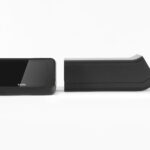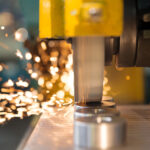The material characteristics E-Modulus, G-Modulus and Poisson constant can be
measured with a single hit on a rectangular sample. Just put the sample on a piece of foam
and hit it between the torsion and bending mode zero lines. Both bending mode frequency
and torsion mode frequency will be measured, E-modulus and G-modulus calculated from
those 2 frequencies (and pre-set dimensions and mass) as well as the Poisson constant of
the material.
Speed of sound can be measured and calculated based on the longitudinal compression
mode resonance frequency. Correlation exists for fe. cement based materials between
breaking strength and Speed of Sound in the material.
Internal friction or damping is calculated for multiple resonance modes as the Width at Half
Height (WHH). With an optional GrindoSonic HT oven unit E, G and Poisson can be measured as a profile against temperature. The temperature of the system can be programmed to test different temperature profiles up to 1200°C, 1500°C or 1800°C under vacuum or inert gas atmosphere. A full spectrogram at every temperature measurement point gives valuable
information on the first order bending, torsion or longitudinal compression modes ( equivalent speed of sound ), as well as their respective first, second or even higher harmonics. The
attenuation ( damping factor ) can be calculated from each of those modes and their
respective higher harmonics, revealing important information on the distributed
mass-spring-damper system under study at different temperatures. All the spectrograms are
brought together in a waterfall plot, giving the overview of the complete visco-elastic thermal
behaviour of the material. Phase changes, recrystallisation and many other material
phenomenons can be identified.
An other import application is the evolution of materials, subject to different loads. This can
be aging cycles, thermoshocks, IR or UV radiation, frost/defrost cycles whereby after
each small step, the measurement can be repeated seen it’s non-destructive nature.
As such a graph of the evolution of the material (fe. E-modulus, attenuation or speed of
sound ) can be measured as a function of increasing load on the sample under test.
Other material characteristics that have a clear dependency on one of the distributed
mechanico-elastic paramerters can as such be measured indirectly:
- surface treatments, added layers,will change the overal stiffness and as such the
bending mode resonance frequency - porosity of the material has a good sensitivity to longitudinal compression mode
- detection of cracks in materials: cracks cause a higher internal friction and will as
such change the damping value. Higher harmonics have a good sensitivity to smaller
cracks. - compound composition variations can be evaluated by comparing resonance
frequencies between different samples
The resolution of the GrindoSonic MK7 frequency measurement is 1 part per million (ppm).
The repeatability is up to +/- 2 ppm and the accuracy up to +/- 5 ppm.
As such the smallest phenomenon’s can be made visible, making this technique one of the
most sensitive measurement methods available to study material characteristics that have a
relation to the distributed mechanico-elastic behaviour. (mass-spring-damper system model)
All of the presented measurements are based on the impulse excitation technique, where
the main course of action consists of 2 steps: “tap” and “read”. This can be performed
manually with the basic GrindoSonic MK7 instrument, or fully automated and in-line as well
as for changing temperatures up to 1800 °C with the GrindoSonic IL and HT systems. The
principle is comparable with the manual and auditive method of “listening” to an impulse
response. However, GrindoSonic adds
● ultra-high precision: repeatability of measurements with a resolution of 1ppm
● documented measurements
● user independent operation
● compact and readable results presented in plots/graph for visual analysis
● full frequency spectrum analysis for advanced and complex cases
● Measurements at room temperature or up to as high as 1800°C.



